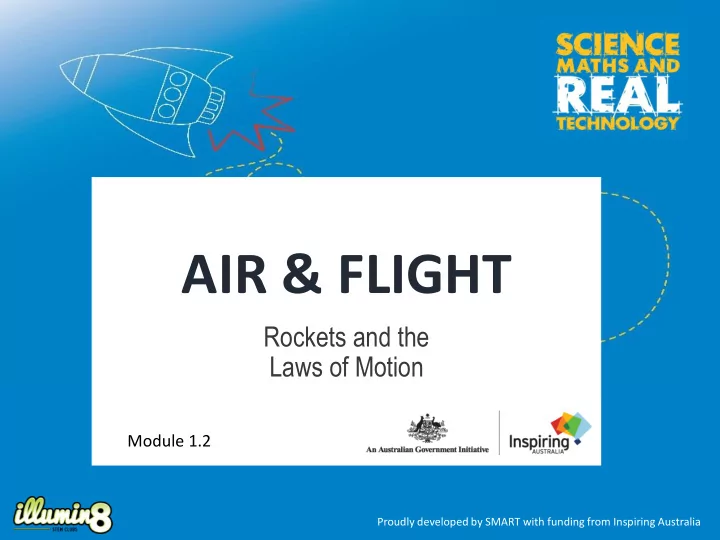

AIR & FLIGHT Rockets and the Laws of Motion Module 1.2 Proudly developed by SMART with funding from Inspiring Australia
Do you think aerodynamics is important for rockets too? Pointed nose cone to push through air more easily, reducing drag Fins and tail to help with stability
Four Forces of Flight The Four Forces of flight also apply to a rocket Rocket Image Source: https://spaceflightsystems.grc.nasa.gov/education/rocket/rktfor.html
Newton’s Laws of Motion Isaac Newton (1642-1727) Newton’s laws explain how forces act on objects! When a force acts on an object that is free to move, the object will move in accordance with Newton’s three laws of motion. Image Source: http://www.sciencekids.co.nz/pictures/scientists/isaacnewton.html
Aim: To observe Newton’s Laws of Motion Equipment : (per group) • 1 egg (or golf ball) • 1 toilet roll • 1 chopping board or 1 piece of thick cardboard • 1 cup, partially filled with water Procedure: 1. Form into groups of 3 to 4 students. In groups: 2. Fill the cup (up to 3 quarters full) with water. 3. Place the board on top of the cup. 4. Place the egg (or ball) on top of the toilet roll (length ways), and then place the toilet roll and egg on top of the board. 5. Ensure the toilet roll and egg are lined up directly above the cup. 6. Swiftly pull the board out from under the toilet roll. 7. Observe where the egg (or ball) lands!
Aim: To observe Newton’s Laws of Motion Equipment: (per group) • 1 x heavy ball (e.g. golf ball, pool ball or marble) • 1 x light ball (e.g. ping pong ball, cotton ball) Procedure: 1. Form into groups of 2 to 3 students. In groups: 2. Place the light ball on a table, and push it carefully across the table. 3. Have a group member count how long it takes the light ball to get to the other side of the table. Record the result. 4. Place the heavy ball on the same table. 5. Push the heavy ball carefully across the table, using the same amount of force as you used for the light ball. 6. Have a group member count how long it takes the heavy ball to get to the other side of the table. Record the result. 7. Compare the time it took for each ball to travel to the other side of the table.
Aim: To observe the effect of a sudden release of air on a balloon. Equipment: (as a group) • Balloons • Tape (masking tape) • String • Straws Procedure: 1. Measure out enough string to span between the walls of the room (create 1 to 3 stringlines). 2. Thread a short straw onto each string line. 3. Set up the stringline(s) by taping either end of the string to opposite walls of the room using masking tape. 4. Inflate a balloon but don’t tie it closed. Pinch the end of the balloon closed by hand. 5. Tape the middle of the inflated balloon onto the straw threaded onto the stringline. 6. Ensure the stringline is secured to the wall at each end. 7. Count down (3, 2,1) and release the balloon. 8. Observe the effect on the balloon. Document your observations!
How do rockets generate thrust? Image Sources: https://pixabay.com/ https://spaceflightsystems.grc.nasa.gov/education/rocket/rktfor.html
Aim: To observe the effect of pressure on a film canister. Equipment: (For coordinator to demonstrate) • 1 to 3 x film canisters • 3-6 x Alka-Seltzer tablets • Bottle of water • Paper towel for cleaning up Procedure: 1. Ensure canister lids are dry, then place half a tablet of Alka-Seltzer (broken into 2 or more pieces) onto each lid. 2. Fill one canister approximately 1/3 full with water. 3. Drop the Alka-Seltzer pieces into the water-filled canister, quickly place the lid on (you should hear a click). Quickly turn the canister over and put it down on the table (lid side down) and walk briskly away (at least 1 metre). 4. Stand back and observe the reaction!
The Challenge: Build a water and air fuelled rocket out of a plastic bottle, and some other small items! We will test, and record: • How far the rockets can travel!
Bottle Rocket Challenge Rules • The bottle rocket must only be fuelled with water and pressurised air from a bike or foot pump. • The rocket launch pad must be in a large open space outdoors. It will be set up at an angle of approximately 45 ° so rockets can be scored on horizontal distance travelled. • Distance measurements will be taken from the front of the launch pad to the middle of the rocket (where it lands). • The best distance out of your three official attempts will be your final score. • No rocket launch will take place until everyone is standing behind the launch pad, out of the rocket’s path. • All rocket launches must be supervised by the coordinator.
Design Your Rocket! • Bottle rockets are to be made from plastic soft-drink bottles. • Other materials may be used to improve the aerodynamics of the rocket. Think about the forces of flight! • Water must be filled into the bottle and used as the fuel. How much you water use can make a big difference to performance! • Air will be pumped through the launcher into the bottle until it is pressurised. • The pressurised air will force the water out of the bottle when released, propelling it into the air.
Recommend
More recommend